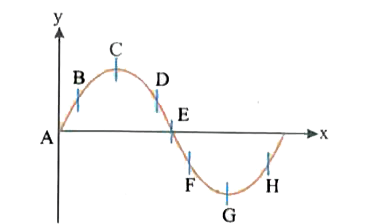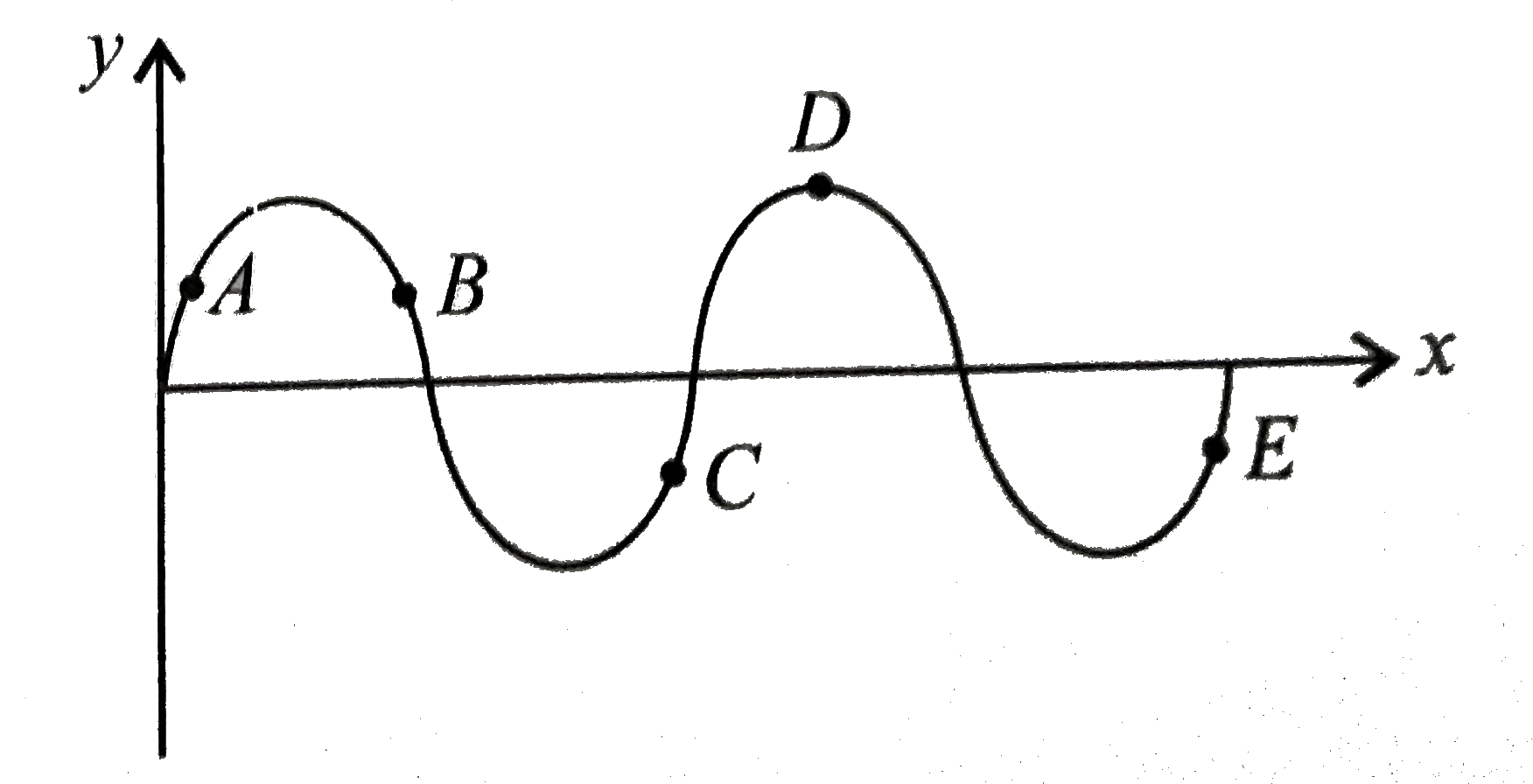A transverse wave is travelling along a string in the positive x-axis. The

shows the photograph of the wave at an instant. Find
(a) the points moving upwards
(b) the points moving downwards
(c ) the points which have zero velocity
(d) the points which have maximum velocity
The correct Answer is:(a) D,E,F , (b) A,B,H , (c) C,G , (d) A,E
(a) D,E,F⇒ (slope =−ve⇒vp=+ve)
(b) A,B,H⇒ (slope =+ve⇒vp=−ve)
(c) At C,G, [slope =0]
(d) At A,E [slope is maximum]
Topper's Solved these Questions
- BOOK - RESONANCECHAPTER - TRAVELLING WAVESEXERCISE - Exercise- 1 PART II31videos
TRAVELLING WAVES
- BOOK - RESONANCECHAPTER - TRAVELLING WAVESEXERCISE - Exercise- 2 PART I21videos
TRAVELLING WAVES
- BOOK - RESONANCECHAPTER - TRAVELLING WAVESEXERCISE - Board Level Exercise27videos
TRAVELLING WAVES
- BOOK - RESONANCECHAPTER - TEST SERIESEXERCISE - PHYSICS127videos
TEST SERIES
- BOOK - RESONANCECHAPTER - WAVE ON STRING EXERCISE - Exercise- 3 PART I19videos
WAVE ON STRING
Similar Questions
A transverse wave is traelling along a string from left to right. The fig. represents the shape of the string (snap-shot) at a given instant. At this instant
(A) Which points have an upward velocity , (B) which points have downward velocity
(C) which point have zero velocity , (D) which point have maximum magnitude of velocity.
 View Solution
View SolutionA transverse wave is travelling along a horizontal string. The first figure is the shape of the string at an instant of time. The second picture is a graph of the vertical displacement of a point on the string as a function of time. How far does this wave travel along the string in one second?
 , View Solution
, View Solution
Knowledge Check
- Question 1 - Select One
A sinusoidal transverse wave is traveling on a string. Any point on the string
Amoves in the same direction as the wave.Bmoves in simple harmonic motion with a different frequency than that of the wave.Cmoves in simple harmonic motion with the same angular frequency as the waveDmoves in uniform circular motion with a different angular speed than the wave. - Question 2 - Select One
A transverse wave travels along x-axis . The particles of medium move
AAlong x-axisBAlong y-axisCAlong z-axisDEither along y- axis or z-axis - Question 3 - Select One
Statement I : The transverse wave is traveling along a string in the positive x-axis is shown. Points (A & P1) moving downward and point (C &P2) moving upward.
Statement II : In a wave propagating in positive x direction, the points with +ve slope move downward and vice versa.
 AIf both statement -I and Statement -II are true , and statement-II is the correct explanation of statement -IBIf both statemenrt-I and Statement-II are true but statement-II is not the correct explanation of statement -ICIf statement -I is true but statement -II is false.DIf statement -I is true but statement -II is true
AIf both statement -I and Statement -II are true , and statement-II is the correct explanation of statement -IBIf both statemenrt-I and Statement-II are true but statement-II is not the correct explanation of statement -ICIf statement -I is true but statement -II is false.DIf statement -I is true but statement -II is true
A transverse wave is travelling along a string from left to right. The figure below represents the shape of the string at a given instant. At this instant the points have an upward velocity are (here X-wave displacement, Y- particle displacement)
 View Solution
View SolutionA wave is travelling along a string. At an instant shape of the string is as shown in the enclosed figure. At this instant, point A is moving upwards. Which of the following statements are correct?
 View Solution
View SolutionA transverse wave travelling along negativ y-axis its snap shot is given at any instant of tie t. points which is having velocity in negative x-direction.
 View Solution
View SolutionA transverse wave travelling along the positive x-axis, given by y=Asin(kx−ωt) is superposed with another wave travelling along the negative x-axis given by y=Asin(kx+ωt). The point x=0 is
View SolutionFigure shows a sinusoidal wave at a given instant.

Which points are in phase?View Solution
